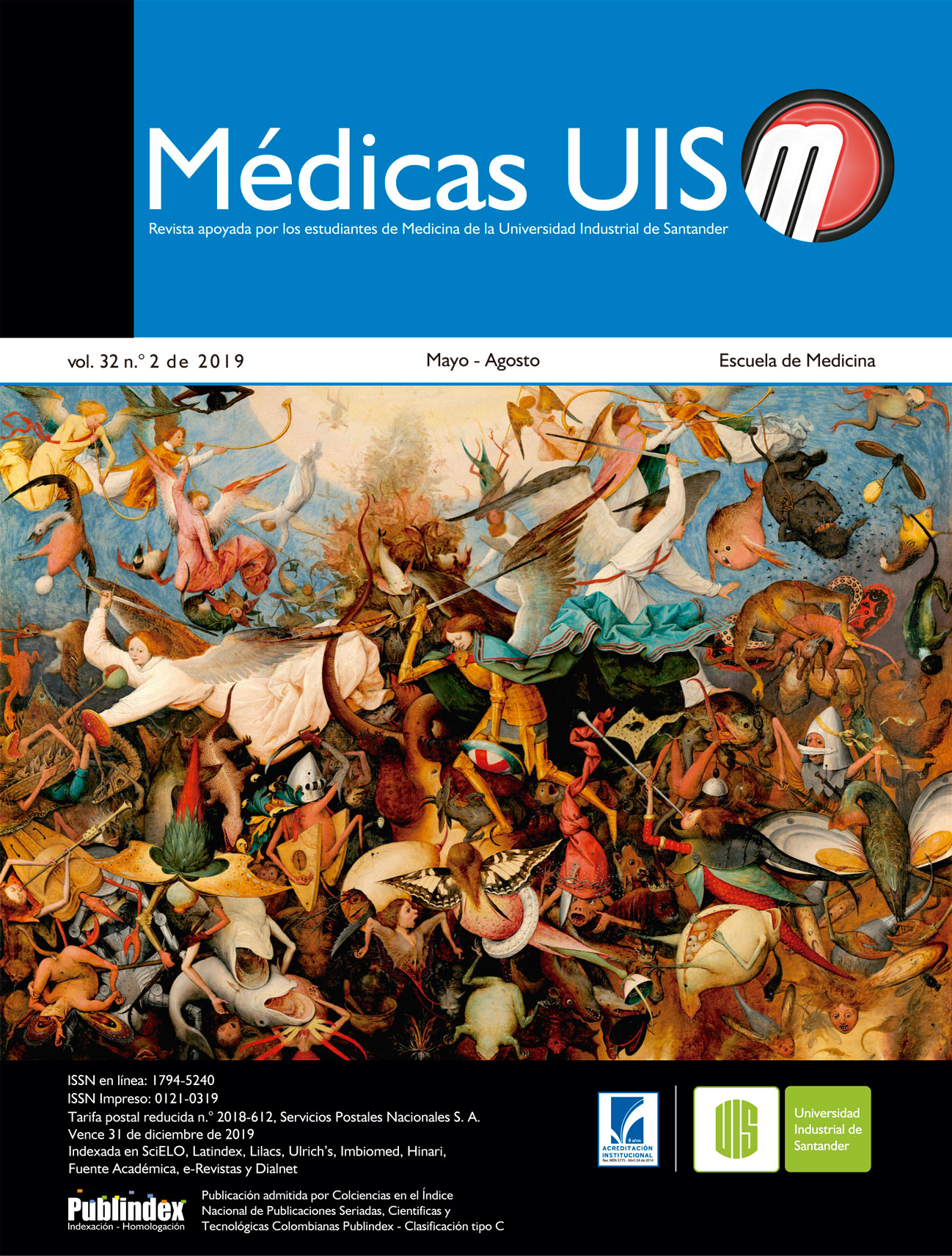Abstract
The nutrition and infant’s health is vitally important in today’s society. The probiotics arise as supplements for the innovation of functional foods for infants. The objective of this review was to find out which probiotics are currently most used in the development of new functional food products for infants. We counted on more than fifty bibliographical references about the development of functional foods from a probiotic bacterium and its healthy benefits, published in the following databases: EBSCO HOST, PLOS and DOAJ. It was found that Bacillus Coagulans emerges as an alternative that improves bioavailability conditions, and studies that investigate the benefits of probiotics
in anthropometric aspect. Recognizing the benefits of probiotics in the health of infants, its application requires greater compliance with criteria of the European Society for Pediatric Gastroenterology, Hepatology and Nutrition. MÉD.UIS.2019;32(2): 31-9
References
2. Sharma Shiwani, Anshul dutt Sharma BC. Functional Food : AReview. J Pharm Res. 2011;4(10):3618–9.
3. Ye W, Chen J, Wang J, Cai Y. The stability of probiotics added to the food. J Chem Pharm Res. 2013;5(12):27–9.
4. Maja B, Marica R, Ljiljana M, Svetlana N, Maja V-S, Aleksandra D-V. Improvement of production performance of functional fermented whey-based beverage. Chem Ind Chem Eng Q. 2012;20(00):96–96.
5. Walsh H, Cheng J, Guo M. Effects of Carbonation on Probiotic Survivability, Physicochemical, and Sensory Properties of MilkBased Symbiotic Beverages. J Food Sci. 2014;79(4).
6. Mpofu A, Linnemann AR, Sybesma W, Kort R, Nout MJR, Smid EJ. Development of a locally sustainable functional food based on mutandabota, a traditional food in southern Africa. J Dairy Sci. 2014;97(5):2591–9.
7. Das A, Ray S, Raychaudhuri U, Chakraborty R. Microencapsulation of Probiotic Bacteria and its Potential Application in Food Technology. Int J Agric Environ Biotechnol. 2014;7(1):47.
8. Bernardeau M, Vernoux JP. Overview of differences between microbial feed additives and probiotics for food regarding regulation, growth promotion effects and health properties and consequences for extrapolation of farm animal results to humans.
Clin Microbiol Infect. 2013;19(4):321–30.
9. Sousa S, Gomes AM, Pintado MM, Silva JP, Costa P, Amaral MH, et al. Characterization of freezing effect upon stability of, probiotic loaded, calcium-alginate microparticles. Food Bioprod Process. 2015;93:90–7.
10. Miyake Y, Yamamoto K. Role of gut microbiota in liver diseases. Hepatol Res. 2013;43(2):139–46.
11. Hickey L, Jacobs SE, Garland SM. Probiotics in neonatology. JPaediatr Child Health. 2012;48(9):777–83.
12. Liu X, Champagne CP, Lee BH, Boye JI, Casgrain M. Thermostability1 of Probiotics and Their α -Galactosidases and the Potential for Bean Products. Biotechnol Res Int. 2014;2014:472723.
13. Van den Nieuwboer M, Brummer RJ, Guarner F, Morelli L, Cabana M, Claassen E. Safety of probiotics and synbiotics in children under 18 years of age. Benef Microbes. 2015;6(5):615–30.
14. Ackerberg TS, Labuschagne IL, Lombard MJ. The use of prebiotics and probiotics in infant formula. South African Fam Pract. 2012;54(4):322–3.
15. F A O Foodnutrition. Probiotics in food FOOD AND NUTRITION. FAO FOOD NUR Pap. 2006;
16. Tintore M. , Colome G., Santas J. EJ. Gut Microbiota Dysbiosis and Role of Probiotics in Infant Colic. Arch Clin Microbiol. 2017;8(4 (56)):1–7.
17. Ganguly NK, Bhattacharya SK, Sesikeran B, Nair GB, Ramakrishna BS, Sachdev HPS, et al. ICMR-DBT Guidelines for evaluation of probiotics in food. Indian J Med Res. 2011;134(7):22–5.
18. Araya M, Morelli L, Reid G, Sanders ME, Stanton C, Pineiro M, et al. Guidelines for the Evaluation of Probiotics in Food. Jt FAO/ WHO Work Gr Rep Draft Guidel Eval Probiotics Food. 2002;1–11.
19. Parlamento Europeo. Reglamento (UE) 2015/2283. D Of la Unión Eur Agencia Estatal Boletín Of del Estado. 2015;327:1–22.
20. Donovan SM, Schneeman B, Gibson GR, Sanders ME. Establishing and Evaluating Health Claims for Probiotics 1,2. Adv Nutr. 2012;3:723–5.
21. De Azevedo MSP, Innocentin S, Dorella F a., Rocha CS, Mariat D, Pontes DS, et al. Immunotherapy of allergic diseases using probiotics or recombinant probiotics. J Appl Microbiol. 2013;115(2):319–33.
22. Martín-Muñoz MF, Fortuni M, Caminoa M, Belver T, Quirce S, Caballero T. Anaphylactic reaction to probiotics: Cow’s milk and hen’s egg allergens in probiotic compounds. Pediatr Allergy Immunol. 2012;23(8):778–84.
23. Hussey S, Wall R, Gruffman E, O’Sullivan L, Ryan CA, Murphy B, et al. Parenteral antibiotics reduce bifidobacteria colonization and diversity in neonates. Int J Microbiol. 2011;2011.
24. Ismail IH, Licciardi P V., Tang MLK. Probiotic effects in allergic disease. J Paediatr Child Health. 2013;49(9):709–15.

This work is licensed under a Creative Commons Attribution 4.0 International License.
Copyright (c) 2019 Médicas UIS
